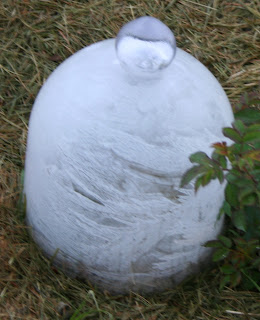 All of you know that I pretty much despise the wildly popular 'Knockout' rose, right? No surprises there for any regular readers. Well, I'll show you a rose that, if we must have a rose whose primary purpose is to bloom and bloom for landscaping enhancement, has 'Knockout' and its relatives beat to shame.
All of you know that I pretty much despise the wildly popular 'Knockout' rose, right? No surprises there for any regular readers. Well, I'll show you a rose that, if we must have a rose whose primary purpose is to bloom and bloom for landscaping enhancement, has 'Knockout' and its relatives beat to shame.That rose is 'Champlain', a 1982 Canadian rose of the Explorer series, named to honor the founder of the city of Quebec, and touted everywhere for its continuous flowering habit by everyone who grows it. In fact, it is the third longest blooming rose of the Canadian releases. I have two, one in full sun in a long border in the garden proper and a shaded one in my front landscaping near the house that has only a northeast exposure. The latter also has a tree to its immediate east, so it might see direct sun 4 hours a day in the summer and barely at all in the winter. Both bloom their heads off, although I have to admit the one in the sun does have a more continuous bloom pattern.
 'Champlain' is a healthy rose, free of mildew and almost free of blackspot (I see a little on them in humid August every other year and they lose some lower leaves). Flowers are bright red (a much better red than vivid pukey off-red 'Knockout'), are 6-7 cm in diameter, and have 30 petals. There is an occasional white streak to the petals as you can see in the second picture. 'Champlain' is a complex hybrid of a cross between 'R. Kordesii' and 'Max Graff' on one side and a seedling from' Red Dawn' and 'Suzanne' on the other. It seems to be easy to start from softwood cuttings because that is where my 2nd plant came from. Hardy to Zone 2, it has never had any dieback here in zone 5. Canadian climates do have some dieback as noted in Robert Osborne and Beth Pownings Hardy Roses.
'Champlain' is a healthy rose, free of mildew and almost free of blackspot (I see a little on them in humid August every other year and they lose some lower leaves). Flowers are bright red (a much better red than vivid pukey off-red 'Knockout'), are 6-7 cm in diameter, and have 30 petals. There is an occasional white streak to the petals as you can see in the second picture. 'Champlain' is a complex hybrid of a cross between 'R. Kordesii' and 'Max Graff' on one side and a seedling from' Red Dawn' and 'Suzanne' on the other. It seems to be easy to start from softwood cuttings because that is where my 2nd plant came from. Hardy to Zone 2, it has never had any dieback here in zone 5. Canadian climates do have some dieback as noted in Robert Osborne and Beth Pownings Hardy Roses. |
| In front, part sun |
 |
| In back, full sun |
I point out that single drawback solely in hopes that not all of you will choose to grow this nearly-perfect landscape rose. If 'Champlain' was grown everywhere by everyone, I'm sure that I wouldn't like it nearly as much. I'm peculiar that way.






